INTERVIEW: Ciro Guerra travels into Amazon for Oscar-nominated ‘Embrace of the Serpent’
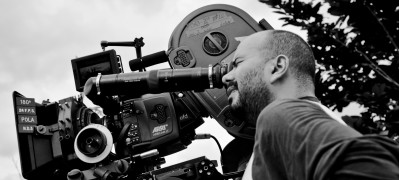
Ciro Guerra, the Colombian director of the Oscar-nominated film Embrace of the Serpent, traveled into the unknown for this cinematic journey. The film is based on the journals of two white adventurers who sought to gather evidence on local horticulture and the indigenous communities of the Amazon River near the border of Colombia and Brazil. However, the cinematic tale is not told from their perspective but from the viewpoint of Karamakate, a local shaman.
The first explorer, Theo (Jan Bijvoet), traveled in 1909 as a research professor for his German university. The audience first sees him ailing from a sickness and in need of help. The second explorer, Evan (Brionne Davis), travels 30 years after Theo to follow in his predecessor’s footsteps. Helping them both is the protagonist of this multi-decade tale, Karamakate (played by Nilbio Torres in 1909 and Antonio Bolivar as an older man). This shaman is, at first, resistant to helping the adventurers, leery of their ambitions and rightfully fearful of their connections to the area’s colonial past and rubber-industry prospects. The communities along the Amazon River have forever been changed by intrusions of people bringing their cultural practices, religion and financial interests to the area. Karamakate knows this and holds his beliefs sacred.
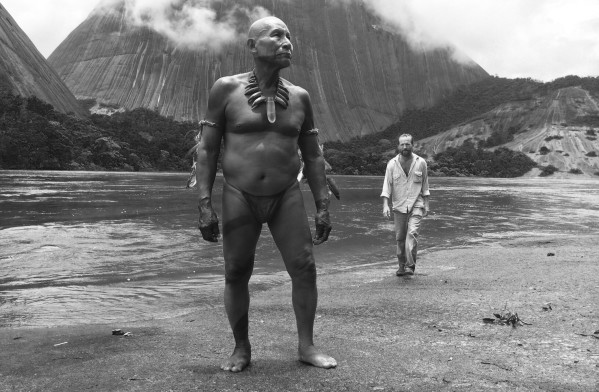
The shaman, in many ways, represents a turning point for both of the white men. He decides to guide them through the forest and along the river, but their goals shift as the journey continues. What they find, what they experience is far more revealing.
Although the movie is a work of fiction, the stories are based on the journals of Theodor Koch-Grünberg and Richard Evans Schultes. Guerra, whose previous films include La Sombra del Caminante and The Wind Journeys, characterized Embrace of the Serpent as his stepping away from the “personal” and moving in the opposite direction.
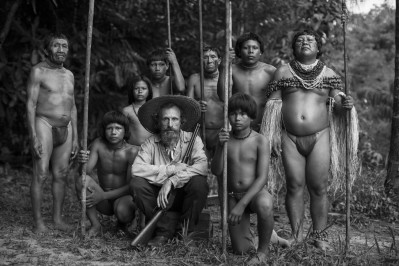
“It just went in the direction of the unknown,” Guerra said recently during a phone interview. “So I wanted to make a film that was about something that was unknown to me, and so I started doing some research. … [The Amazon region has] always been a big mystery for me and most of the people in my country, so when I started to do some research about it, an anthropologist friend of mine gave me the journals of the explorers. … When I started reading them, I discovered a story that I found fascinating and that I couldn’t believe it had never been told.”
Guerra called the filmmaking process “very risky.” They shot the picture in Vaupés, a remote area of Amazonia on the border of Colombia and Brazil. The process took seven long weeks and endured many logistical obstacles. However, the result is the first Colombian film told from the perspective of an indigenous protagonist and the first film to shoot in the Colombian Amazon in three decades.
“So this is a place where you have to bring everything because there’s nothing there, and a really small problem becomes a huge problem in terms of logistics,” he said. “But we managed to find a crew that was adventurous and [had] … a real passion for the project. So they pulled it through, through all the difficulties.”
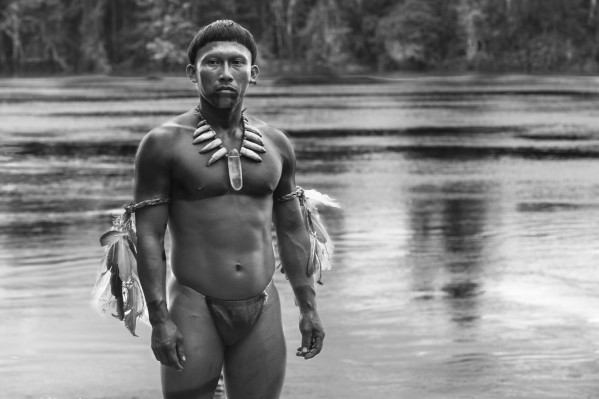
Of the actors, the indigenous characters are played by “real indigenous people,” Guerra said. The white characters are played by professional actors. “We have a contrast between people coming from different worlds altogether,” he said, and this seems to fit the surroundings. The Amazon is a multicultural region featuring numerous cultures, languages and histories. For example, the region where Embrace of the Serpent was filmed includes 70 different languages.
“We were able to communicate with the indigenous people through Spanish because Spanish is a second or third language,” Guerra said. “So the challenge was for Brionne the American actor and for Jan the European actor. … So we sent them every piece of dialogue [and] … how it was meant to be pronunciated, and they just did their homework.”
Throughout the narrative, Karamakate shares many of his beliefs and cultural practices, including not eating fish before the rains come and other “prohibitions.” The explorers respect his beliefs, but they don’t seem to practice them. They have difficulty overcoming their scientific minds and following in the footsteps of their guide. This back and forth between cultures and beliefs is one of the hallmarks of Embrace of the Serpent, known as El Abrazo de la Serpient.
One telling scene has Theo, after a visit with old friends, looking for his compass among the community on the banks of the river. His guide tells him to leave the device, but he insists that he needs the compass. The reasoning may surprise audience members; it’s not the value of the compass or his own journey he is considering. Instead, Theo doesn’t want to introduce the compass as a tool in the culture because this community navigates by the stars and other natural signs. In response, Karamakate offers sentiments about the universality of knowledge and reminds the explorer that it’s anyone’s right to learn.
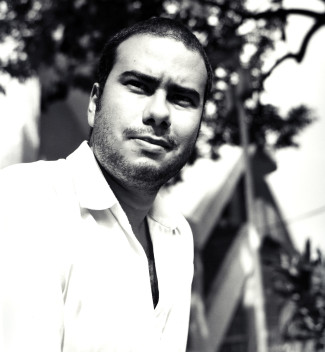
“It’s different in every community,” Guerra said of the indigenous communities. “Their main concern is to live a peaceful, quiet life, so they are very respectful. So these are not people that hold too much grudge to outsiders. … They are always looking forward. They are not people that live in the past. There are, however, some that hold grudges, especially because they have a lot of influence from foreign influence. … But most of them are just very peaceful, quiet, joyful people.”
Guerra said the relationships in the movie, and the interaction between the communities and other cultures to this day, are a “complex thing.” The director said he believes that those native to the land should be allowed to make their own decisions on what they take culturally and what they don’t take, what they preserve and what they don’t preserve.
“They don’t want to be who they were 100 years ago anymore than you,” he said. “They just have an open understanding of the way knowledge works, and they have deep respect. They’re way more respectful of other kinds of people, and other ways of thinking and other ways of understanding than we are.”
The journals, which serve as the film’s source material, are based in scientific observation. There’s no dramatic storytelling among their pages, so Guerra and his co-writer Jacques Toulemonde created the fictional story of Karamakate and his interactions. “We lifted from scientific truths in order to find deeper truths,” he said.
The director hopes Embrace of the Serpent, which starts a two-week run at New York City’s Film Forum Wednesday, Feb. 17, will instigate audiences to have a dialogue. The film will undoubtedly receive much spotlight, thanks to its Best Foreign Language Film nomination at the Academy Awards.
“The main satisfaction that we get is to be able to make the film, to be able to finish it and to be able to share it with audiences,” he said. “That just makes us so happy, and from there on, we’re just thankful for everything that’s happened. Now with this, of course, we get an Academy Award nomination. The film has now been discovered by a much wider audience.”
Embrace of the Serpent leads the charge of a new wave of films coming from Colombia. Although many of them don’t find American distributors and are tough to find in local movie theaters, American audiences are increasingly receiving more exposure to new ideas from South America and other parts of the world. Now that they’re being made, there will be a push to have them travel to the United States.
“Colombia has a very rough, difficult history, but now there’s finally some government support,” Guerra said of the filmmaking community in his home country. “We all know each other, and we’re all part of the same community. And we’re all very collaborative. … Yet it’s very difficult for those films to get distribution, even in Colombia. That’s the main challenge now is to find a way for these films to be seen.”
Looking back on his long journey into Amazonia to tell the story of Karamakate, Guerra said he has learned to “see the world from a different perspective.”
“I shed a lot of spiritual, emotional and intellectual weight,” he said. “Now I feel much lighter. That’s the best way that I can sum up something that really cannot be summed up into words.”
By John Soltes / Publisher / John@HollywoodSoapbox.com
- Embrace of the Serpent will open at New York City’s Film Forum Wednesday, Feb. 17. Click here for more information.

